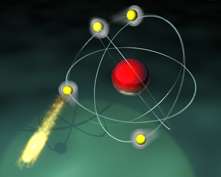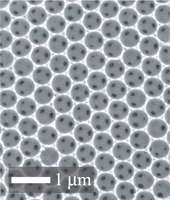Emission of light under control: "lifetime-warp" in a photonic crystal

When you flip a light switch, a steady stream of photons is emitted by millions of atoms inside a light bulb. All atoms emit light at random instants in time, just like rain drops ticking on a roof.
A team of researchers from the Netherlands (University of Twente, Utrecht University) has succeeded in controlling the pace of light emission, varying from a light drizzle to a rainstorm. In the process, the team has verified a 17-year old prediction of American physicist Eli Yablonovitch that ignited a world-wide rush to build tiny "chips" that control light beams.
The achievement of Dr. Lodahl and a team of physicists and chemists is being reported on August 5 in the journal Nature.
Researchers say it has many potential uses, not only as a tool for controlling quantum optical systems, but also in efficient miniature lasers for displays and telecom, in solar cells, and even in future quantum computers.
Elementary quantum mechanics (notably developed by Niels Bohr and Albert Einstein) says that an atom in a state of high energy returns to its low energy state after a random time. The average time of emission is called the lifetime. In the process, the atom emits energy in the form of a photon, or a light particle (see Fig. 1). This is how the sun emits light, thereby permitting life on earth.
Controlling the emission of light is one of the main goals in science and technology. How can atoms be manipulated such that you can have them emit light when you want?
It has been theoretically predicted in 1987 that the emission of light can be completely controlled by means of a photonic crystal. A photonic crystal is an ordered structure composed of tiny voids (see Fig. 2). Such a structure reflects light in unusual ways similar to mother-of-pearl or the gemstone opal.

To manipulate the emission of light, the researchers have made photonic crystals consisting of ordered arrays of spherical air voids in the solid material titania, the material that renders paint, paper or toothpaste its whiteness.
The photonic crystals are made by growing an artificial opal from small plastic spheres, filling the space between the spheres with the solid material, and finally removing the opal material. Such a photonic crystal is also known as an "inverse opal" (Fig. 2). The distances between the air spheres were made to vary between 240 and 650 nanometers. The crystals are 2 millimeters across and 0.3 millimeters thick, consisting of thousands of air spheres in each direction.
The photonic crystals were intentionally infiltrated with tailor-made colloidal particles consisting of the semiconductor cadmium selenide. The particles are only 4.5 nanometers in diameter, and behave very similarly to light as atoms do, hence their name "artificial atoms".
In the experiments, an artificial atom is brought to a high energy state by a short pulse from a laser. Usually, the artificial atom returns to its low energy state after an average lifetime. However, since the artificial atom is inside a photonic crystal, the moment of emission of the photon is delayed or speeded up at will, in agreement with theoretical predictions. To an artificial atom, it appears as if time has been warped (see Fig. 3).

Photonic crystals that delay emission of light and thus store energy may find applications in solar cells: sun light is converted to a high energy state of atoms in a solar cell. The energy harvesting can be made efficient since energy is not leaking away as emitted light.
Accelerated emission in photonic crystals have great potential for highly efficient light emitting devices, since more photons are emitted per second. This is favorable for miniature lasers and light emitting diodes that are omnipresent in dashboards in cars, DVD players, and range finders.
Optimized emission efficiency is also favorable to create single-photon sources, that emit a steady stream of photons like a dripping water tap. Single photon sources are very useful in quantum-information processing, wherein information is contained in an unbreakable code on each photon.
Photonic crystals could even become essential building blocks for quantum computers. The new results demonstrate that ubiquitous quantum vacuum fluctuations of light are controlled. This is important to achieve error-free quantum computations in future superfast and "unhackable" quantum computers.
Source: University of Twente


















